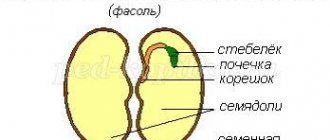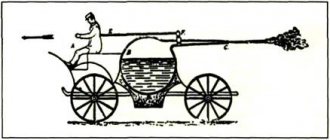- Reports
- Mathematics
- Axial and central symmetry
Symmetry is an integral part of the world in which we live. We admire the beauty of nature, architectural structures, mechanical devices and masterpieces of art, without thinking about the fact that symmetry is the basis of their creation.
“Symmetry” is translated from Greek as harmony, proportionality, beauty. The term was first widely used by Pythagoras in BC. He used it to designate a three-dimensional image of geometric figures and their parts in space. The scientist also defined deviation from symmetry as asymmetry.
There are two main types of symmetry: axial and central.
Axial symmetry or mirror symmetry is symmetry about an axis. That is, one half of the figure is completely commensurate with the other, relatively straight. So if you bend a sheet of paper in half, then each point on one half of the sheet will have its counterpart on the other half, and the fold itself will become an axis of symmetry.
Mirror symmetry can be observed in nature: plant leaves are symmetrical relative to the average stem, butterfly wings are a mirror image of each other, humans and animals have symmetry in the arrangement of body parts. Architectural structures are also a prime example of axial symmetry. The facades of buildings, especially antique ones, evoke feelings of severity and admiration for beauty precisely because of the symmetry of their parts. Symmetry in architecture serves not only for the aesthetic pleasure of observers, but also guarantees the strength and reliability of the structure for buildings and structures.
Central symmetry is symmetry about a point. Such symmetry necessarily has a fixed center; with rotational actions of 180° relative to it, the figure turns into itself. Thanks to this property, central symmetry received a second name - rotational symmetry. Since ancient times, the circle has been considered its standard, and indeed, no matter how we rotate it around the center, each point of the circle passes into its corresponding one. In nature, snowflakes are a striking example of central symmetry; flowers of plants such as dandelion, coltsfoot, as well as chamomile, if the number of its petals is even; gears of mechanisms.
Option 2
Probably everyone has heard such concepts as “symmetry”, “symmetrically” and the like. But there are people who do not understand the meaning of these synonyms. So what is symmetry? Where is it used? And what varieties are there?
A short excursion about symmetry in general terms.
I will try to explain the concept of symmetry using an example. Imagine an ordinary butterfly. Okay, now we need to draw a line through it. When the line is finally drawn, you need to look at the right and left parts of the drawing. If these 2 parts of the picture are the same in size and proportions, then this can be called a symmetrical model. In short, symmetry is the complete proportionality of body parts in relation to the line. Where does symmetry apply? Well, symmetry is found wherever possible. Geometry, physics, biology, chemistry, culture - all contain symmetry, and each is different from the other. There is also the concept of asymmetry. That is, the lack of correct proportionality. It is also worth noting that symmetry is not always exact.
Some types of symmetry, their characteristics and applications.
In total there are a dozen different types of symmetries. But it is necessary to consider only those that occur frequently. It’s worth saying right away that both of them are used in solving geometry problems. So, here are 2 main types of symmetry:
Axial symmetry.
This type of symmetry is divided into 4 groups that differ from each other.
1) Reflective symmetry is a mirror movement in which points that do not move anywhere are connected into one line - the axis of symmetry. The rectangle and parallelogram are great examples.
2) Rotational symmetry is axial symmetry, which is relative to rotations around an axis.
3) Axial symmetry of the nth order is symmetry with respect to rotations of 360 degrees around an axis.
4) Mirror rotational axial symmetry of the nth order is the same, only perpendicular to the axis.
Central symmetry.
This is a transformation in which each point A goes to point A1, while it is symmetrical to the previous one relative to the O axis. This symmetry is, in fact, the same 180-degree rotation in planimetry. What distinguishes central symmetry from axial symmetry is that in the first case there is movement.
Axial and central symmetries. Conducting a lesson with EFU
- Visit LECTA's free Classwork service. To help the teacher, the “Classwork” service provides lesson plans for mathematics - calendar and thematic planning and methodological recommendations for each stage of the lesson. Lesson developments in mathematics contain interactive materials for studying each topic and interactive tasks for each lesson, mathematical dictations and tests for organizing knowledge testing.
- Open the EFU “Mathematics. 6th grade" (UMK A.G. Merzlyak). The topic we need is discussed in paragraph 44.
- Open lesson developments for this textbook in the “Classwork” service. The topic “Axial and central symmetries” is discussed in three lessons - 127-129. You can download these lesson plans in this article, and for all other lessons, follow the link above.
Lesson developments for teaching materials “Mathematics. 6th grade" A.G. Merzlyak were developed in accordance with the basic provisions of the Federal State Educational Standard LLC and formed the basis of a system of lessons, each of which contains everything necessary for conducting a lesson in the sixth grade.
Repetition of material
From the 5th grade mathematics course, students have already learned how figures that have an axis of symmetry look and are constructed. Before studying the topic “Axial and central symmetries”, it would be advisable to repeat the 5th grade material. It should be explained to students that the construction of a figure in many cases is possible based on the position of key points. Teacher: A segment can be determined by the position of the ends, a triangle - by the location of the vertices. What other examples can you think of? Students: A square with 4 points, for example... And a rhombus! Teacher: That's right.
To build a figure that will be symmetrical to our triangle or rhombus, we need to reflect its key points. To consolidate this intuitive and visual understanding, the teacher can ask the children to fold a sheet of paper on which symmetrical figures are depicted.
.
Symmetry concept
The word "symmetry" comes from the Greek symmetria, which means proportionality.
In our case, symmetry is the property of geometric shapes to be displayed. Teacher: Symmetry has been used in drawings, ornaments, and architecture since ancient times.
Where else can people use symmetry? Students: during the construction of houses; in the manufacture of household items. Teacher: true, but symmetry is widespread not only where man created! We see symmetrical objects in nature every day. Give me three such objects! Students: Butterfly, flowers, leaf shape!
Starfish, snowflake, cross-section of an apple. There are many symmetries, as strange and curious as it may seem to you, but we will consider two symmetries on the plane: with respect to a point and a line.
Axial symmetry
Axial symmetry is symmetry relative to a drawn straight line (axis).
Note that any two figures that are symmetrical about a certain line are equal (Fig. 131). All points of a figure that has an axis of symmetry that do not belong to this axis can be divided into pairs of symmetrical points (Fig. 132).
Central symmetry
Symmetry about a point is called central symmetry.
Figures that have a center of symmetry are a concept that is more difficult to perceive by students than figures that have an axis of symmetry.
For ease of perception and understanding, it is recommended to give as many examples as possible from the surrounding nature. Depending on the level of mathematical preparation of the students in the class, you can draw their attention to the fact that a straight line is a figure that has infinitely many axes and centers of symmetry.
Using assignments from “Classwork”, the material can be consolidated in various graphic formats.
Updating knowledge
For each paragraph in the textbook, problems are selected for independent solution.
The tasks are distributed across three levels of difficulty - from simple to difficult. For additional motivation of students and practical application of acquired knowledge, it is proposed to solve a special problem “From the Wise Owl” - here students will need to show ingenuity and ingenuity. Another section that will invariably interest both young discoverers and teachers is the section “When the lessons are done,” in which you can learn about important mathematical objects and the history of their appearance. Invite the children to solve task No. 1260.
Which printed letters of the Russian alphabet have 1) a vertical axis of symmetry;
2) horizontal axis of symmetry; 3) horizontal and vertical axes? You can download the finished bright handout “Alphabet” at the end of this article.
We also recommend that you use various methods of presenting information in the lesson: both visual and audio. Try audio dictation.
Lesson “Axial and central symmetry” lesson plan (geometry, 8th grade) on the topic
Lesson “Axial and central symmetry”
Lesson objectives:
Educational:
formulate the concept of axial and central symmetry,
consider the idea of symmetry in mathematics, physics, chemistry, biology.
Developmental:
to intensify independent and research activities of students,
develop cognitive activity,
learn to summarize and systematize the information received.
Educational:
Cultivate a culture of thinking and communication skills.
Stage I. Immersion in the topic.
We are going on a journey (slides with images of various architectural structures, patterns on buildings, examples of living nature with symmetry are provided)
There is handout material on the tables.
Task: distribute it into groups according to certain characteristics, and at the end of the lesson we will distribute these cards in terms of geometry.
What concept do you think we will study today?
Answer: symmetry.
Today in the lesson we will study what symmetry is and consider its manifestation in other disciplines: algebra, physics, chemistry, biology.
Symmetry is a concept that means persistence, repeatability, “invariance” of any structural features of the object being studied when certain transformations are carried out with it.
This phenomenon was studied in more detail by the German mathematician Hermann Weyel, writing the book “Symmetry”. He said about symmetry: “Symmetry is the idea through which man has tried for centuries to build and create order, beauty, perfection” (Slide)
An excerpt from the work of L.N. is given. Tolstoy's "Adolescence"
“Once, standing in front of a black board and drawing different figures on it with chalk, I was suddenly pierced by a thought: Why is symmetry pleasing to the eye?
What is symmetry? “It’s an innate feeling,” I answered myself. What is it based on? Is there symmetry in everything in life?”
Nature gave us symmetry, and man studies this phenomenon.
Let's consider this phenomenon from the point of view of geometry.
Stage II. Learning new material.
Students into groups.
After completing laboratory work No. 1A. No. 1B, No. 2A, No. 2B, you need to formulate definitions of which two points are called symmetrical with respect to a straight line and with respect to the center, answer an additional question, view the slide, checking whether you are right.
Laboratory work No. 1A.
1.take a sheet of white paper and fold it in half
2. Drop a drop of paint on it (let it be a blot A), fold the sheet in half, and then straighten it
3. On the other side of the sheet you will receive the same blot (let it be A1 blot)
4. Connect A and A1 with a segment
5. Measure the distance from A and from a1 to the fold line
6. Compare these distances.
Definition: Two points A and A1 are called symmetrical with respect to a line if this line passes through the __________ segment AA1 and _______ to it.
Laboratory work No. 1B.
- Take a sheet of white paper and fold it in half.
- Pierce the double sheet with a needle and then straighten it out.
- You got two points. Label one with the letter A and the other with A1.
- Connect A and A1 with a segment.
- Measure the distance from A and from A1 to the fold line.
- Compare these distances.
Definition: Two points A and A1 are called symmetrical with respect to a line if this line passes through _________
Segment AA1 and __________ to it.
Representatives of the groups report on what happened and draw conclusions.
Laboratory work No. 2A.
Construct the segment AA1 and find its midpoint, point O.
Formulate a definition of points symmetrical about the center after viewing the slide.
Definition: Points A and A1 are called symmetrical relative to point O. if_________
Write the definition in your notebook and check your answer with the answer on the slide.
Laboratory work No. 3A.
1.construct a rectangle.
2.On its two opposite sides, mark the midpoints of the sides.
3. Draw a straight line through these two points.
4.On one side of this line, mark point K
5. Construct point K1 symmetrical to point K relative to the straight line.
6. Draw a conclusion: if point K belongs to a rectangle, then where is the point symmetrical to it?
Definition: A figure is called symmetrical with respect to a straight line if for each point of the figure _____ its symmetrical point is also _______ to this figure.
Check your conclusion using the slide.
Laboratory work No. 3B.
- Construct a parallelogram ABCD.
- Draw the diagonals of the parallelogram.
- Mark their intersection point O.
- Mark an arbitrary point M on side AB and construct point M1 symmetrical to point M relative to center O.
- Mark point N on the diagonal AC, different from point O, and construct point N1 symmetrical to point N relative to center O.
- Draw a conclusion: if a point belongs to a parallelogram, then where is the point symmetrical to it?
Definition: A figure is called symmetrical about the center if, for each point of the figure, a symmetrical point is also _____ to this figure.
Check your conclusion using the slide.
Students then return to the beginning of the lesson. Pictures are grouped from a mathematical point of view.
Turn to the slide.
They draw conclusions.
Stage III. Practical part. (take a test to verify acquired knowledge using the COR)
Stage IV. Application of symmetry in various fields of science.
The idea of symmetry is often the starting point in the hypotheses and theories of scientists of past centuries who believed in the mathematical harmony of the universe.
Thus, the ancient Greek philosopher Plato attached special importance to regular polyhedra, considering them to be the personification of the four natural elements:
Fire is a tetrahedron, earth is a cube, air is an octahedron, water is an icosahedron, the universe is a dodecahedron. (slide)
Symmetry is also present in algebra.
The graphs of a quadratic and cubic parabola are considered, and the type of symmetry the graphs of these functions have is discussed. (slide)
Symmetry is present in physics, chemistry, biology.
Slide. Symmetry in physics.
The EUM principle of relativity of Galileo and Einstein is considered,
EUM “Interrelation of magnetic and electric fields”, EUM “Magnetic fields of planets and the Sun”.
Slide. Symmetry in chemistry.
EUM “Structure and properties of solids”, model - crystal lattice of table salt.
Slide. Symmetry in biology.
Virus symmetry model (Slide)
Symmetry in plants, animals, and humans is considered.
Slide. Symmetry in architecture.
Symmetry in painting, sculpture, music, and poetry is considered.
Stage V Summing up the lesson.
The sphere of influence of symmetry is limitless: nature, science, art. Symmetry determines the harmony of nature, the wisdom of science and the beauty of art.
Stage VI. Homework.
Fill in the free parts of the pictures with numbers and figures, taking into account the type of symmetry and formulas for calculation. (Handout)
VII stage. Reflection.
(the teacher has prepared paper telephone numbers)
The teacher asks to exchange SMS messages about how the lesson went and how fruitfully everyone worked.






